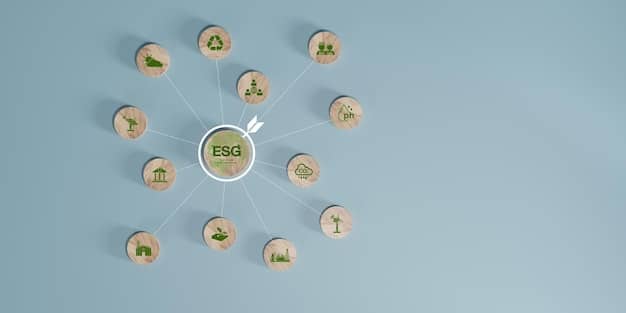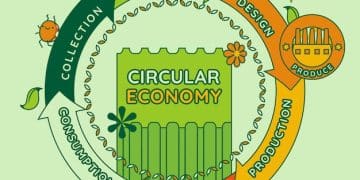Businesses & Sustainability: Best Practices & Case Studies

Businesses are increasingly pivotal in driving environmental and social progress through sustainable practices, fostering innovation and resilience while addressing climate change and resource depletion.
In an era defined by environmental urgency and social consciousness, the role of businesses in promoting sustainability: best practices and case studies has never been more critical. Exploring how corporate entities are shifting towards more responsible operations offers valuable insights into a future where economic growth aligns with ecological well-being and social equity.
The Imperative of Corporate Sustainability
Corporate sustainability is no longer merely a buzzword; it is a fundamental pillar for long-term viability and societal well-being. This shift is driven by increasing consumer awareness, regulatory pressures, and a growing understanding of the direct financial and reputational benefits.
Defining Corporate Sustainability and Its Scope
At its core, corporate sustainability involves managing environmental, social, and governance (ESG) considerations proactively. It encompasses a broad spectrum of activities, from reducing carbon footprints to ensuring fair labor practices across supply chains. The scope extends beyond simple compliance, aiming for a positive net impact.
- Environmental Stewardship: Minimizing ecological harm through efficient resource use and waste reduction.
- Social Responsibility: Promoting equitable practices for employees, communities, and stakeholders.
- Robust Governance: Ensuring ethical leadership and transparent decision-making processes.
Businesses recognizing this imperative are integrating sustainability into their core strategies, not just as an add-on. This comprehensive approach enables them to mitigate risks, unlock new market opportunities, and enhance their brand value significantly.
Why Businesses Must Act Now
The urgency for businesses to embrace sustainability stems from intersecting global challenges: resource scarcity, climate change, and social inequality. Delaying action carries substantial risks, including supply chain disruptions, increased operational costs, and diminished consumer trust.
Conversely, businesses that lead in sustainability often gain a competitive edge. They attract a new generation of talent, appeal to environmentally conscious investors, and build deeper, more resilient relationships with their customers and communities.
Ultimately, acting now is not just about avoiding negative consequences; it is about seizing opportunities to build more resilient businesses and contribute meaningfully to a sustainable global economy.
Best Practices in Sustainable Business Operations
Implementing sustainable business operations requires a holistic approach, integrating environmental and social considerations into every facet of a company’s activities. Pioneers in this field often demonstrate a commitment that goes beyond mere compliance, embedding sustainability into their core values and processes.
Embracing Renewable Energy and Energy Efficiency
One of the most direct ways businesses can reduce their environmental footprint is by transitioning to renewable energy sources and enhancing energy efficiency. This involves investing in solar panels, wind turbines, or purchasing renewable energy credits to offset conventional energy consumption.
Energy efficiency measures, such as upgrading to LED lighting, optimizing HVAC systems, and implementing smart building technologies, can significantly lower operational costs while reducing greenhouse gas emissions. Companies like Google have made substantial commitments to powering their operations entirely with renewable energy, setting a high standard for corporate responsibility.
Circular Economy Principles and Waste Reduction
Moving away from a linear “take-make-dispose” model, many businesses are adopting circular economy principles. This involves designing products for durability, reusability, and recyclability, thereby minimizing waste and maximizing resource utilization.
- Product Design: Creating products that can be easily disassembled and their components repurposed.
- Waste Valorization: Transforming waste into valuable resources through recycling or upcycling initiatives.
- Extended Producer Responsibility: Taking responsibility for products throughout their lifecycle, including their end-of-life.
Companies like Interface, a leading manufacturer of modular carpet tiles, have pioneered circular economy practices by using recycled materials and taking back old products to turn them into new ones.
Sustainable Supply Chain Management
A business’s sustainability impact often extends far beyond its direct operations, encompassing its entire supply chain. Implementing sustainable supply chain management involves rigorously vetting suppliers for their environmental performance, labor practices, and ethical conduct.
This includes ensuring fair wages, safe working conditions, transparent sourcing of raw materials, and minimizing transport emissions. Collaboration with suppliers to build their own sustainability capabilities is also crucial, fostering a ripple effect across the industry. Patagonia, for instance, is renowned for its commitment to ethical sourcing and transparency throughout its supply chain.

Case Studies: Leading the Way
Examining specific case studies provides tangible evidence of how businesses are successfully integrating sustainability into their models. These examples illustrate diverse approaches and demonstrate the tangible benefits of a committed sustainable strategy.
Patagonia: A Model for Environmental Activism and Business Success
Patagonia, the outdoor clothing and gear company, is perhaps one of the most widely recognized leaders in corporate sustainability. Their mission statement itself highlights their commitment to “using business to inspire and implement solutions to the environmental crisis.”
Their practices include:
- Using Recycled Materials: A significant portion of their products are made from recycled content, reducing reliance on virgin resources.
- Worn Wear Program: Encouraging customers to repair, reuse, and recycle their garments to extend product lifespan.
- 1% for the Planet: Donating 1% of their sales to environmental organizations, regardless of profitability.
Patagonia’s dedication to sustainability has not hindered its financial success; instead, it has fostered fierce customer loyalty and strong brand recognition, demonstrating that purpose-driven business can also be profitable.
Interface: Reinventing an Industry with Circularity
Interface, a global manufacturer of modular flooring, embarked on its sustainability journey in the mid-1990s with a bold vision: “Mission Zero” – to eliminate any negative impact it might have on the environment by 2020. They achieved many of their goals and continue to innovate.
Their key initiatives include:
- Net-Works Program: Partnering with coastal communities to collect discarded fishing nets, which are then recycled into new carpet tiles, providing income for locals and cleaning oceans.
- Biophilic Design: Integrating natural elements and processes into product design and manufacturing, focusing on positive impacts.
- Carbon-Negative Products: Developing products with a negative carbon footprint from raw materials to manufacturing.
Interface’s journey illustrates how an established industry player can transform its business model to become a leader in circular economy principles, proving that innovation and sustainability can go hand-in-hand.
Microsoft: Ambitious Goals for a Carbon-Negative Future
Microsoft has made some of the most ambitious corporate sustainability commitments, aiming to be carbon negative by 2030 and to remove all the carbon they’ve emitted since their founding by 2050. This involves significant investment in carbon removal technologies and renewable energy.
Their strategy includes:
- Investing in Carbon Removal: Funding and deploying technologies that remove carbon dioxide directly from the atmosphere.
- Enhancing Operational Efficiency: Optimizing data centers and other facilities to reduce energy consumption.
- Promoting Sustainable Computing: Developing tools and services that help customers and partners reduce their own environmental footprint.
Microsoft’s commitment demonstrates how large technology companies can leverage their resources and influence to drive large-scale environmental improvements, setting a precedent for corporate climate action.
Measuring and Reporting Sustainability Performance
For sustainability initiatives to be effective and credible, businesses must establish robust frameworks for measuring, reporting, and verifying their environmental and social performance. Transparency and accountability are paramount in building trust with stakeholders.
Key Metrics and KPIs for Sustainability
Businesses utilize a range of metrics and Key Performance Indicators (KPIs) to track their progress. These can vary depending on the industry and specific goals but generally include:
- Carbon Footprint: Measuring greenhouse gas emissions (Scopes 1, 2, and 3).
- Water Usage: Tracking consumption and identifying areas for reduction and recycling.
- Waste Diversion Rates: Proportion of waste diverted from landfills through recycling, composting, or reuse.
- Employee Diversity and Inclusion: Assessing workforce demographics and equitable practices.
- Supplier Sustainability Scores: Evaluating the environmental and social performance of supply chain partners.
Implementing these KPIs allows businesses to identify areas for improvement and demonstrate tangible progress. Regularly reviewing these metrics is critical for adaptive management.
Sustainability Reporting Standards and Frameworks
Several internationally recognized standards and frameworks guide businesses in their sustainability reporting, ensuring comparability and credibility. Adhering to these standards helps companies communicate their performance clearly and consistently.
- Global Reporting Initiative (GRI): A widely used framework that provides comprehensive guidelines for reporting on economic, environmental, and social impacts.
- Sustainability Accounting Standards Board (SASB): Offers industry-specific standards that identify financially material sustainability information.
- Task Force on Climate-related Financial Disclosures (TCFD): Focuses on reporting climate-related financial risks and opportunities.
By adopting these frameworks, businesses can provide stakeholders with transparent and reliable information, fostering greater confidence in their sustainability commitments.
The Role of Third-Party Verification and Certifications
To enhance the credibility of their sustainability claims, many companies opt for third-party verification and certifications. These external audits provide an independent assessment of a company’s performance against established standards, adding a layer of assurance for investors and consumers.
Examples include B Corp certification, which assesses a company’s entire social and environmental performance, and various ISO standards (e.g., ISO 14001 for environmental management systems). Such certifications signal a serious commitment to sustainability and can differentiate a brand in a competitive market.
Challenges and Opportunities in Corporate Sustainability
While the momentum for corporate sustainability is strong, businesses still face significant challenges in their journey towards truly sustainable operations. Yet, these challenges often present opportunities for innovation, growth, and greater societal impact.
Overcoming Barriers to Implementation
The journey to sustainability is rarely linear. Common barriers include initial investment costs, lack of internal expertise, resistance to change, and the complexity of global supply chains. Small and medium-sized enterprises (SMEs), in particular, may find it challenging to allocate resources for comprehensive sustainability programs.
Addressing these barriers requires strategic planning, strong leadership commitment, and effective communication across all levels of the organization. Government incentives, industry collaborations, and accessible financing options can also play a crucial role in lowering these hurdles.
Innovation as a Driver for Sustainable Solutions
Necessity is the mother of invention, and the push for sustainability is spurring unparalleled innovation. Businesses are investing in research and development to create new materials, cleaner manufacturing processes, and more energy-efficient technologies.
The transition to a green economy is opening up entirely new markets for sustainable products and services, from renewable energy solutions to eco-friendly packaging. Companies that embrace this challenge as an opportunity to innovate are positioning themselves as future leaders. This innovation often leads to long-term cost savings, new revenue streams, and enhanced brand reputation.
The Competitive Advantage of Leading on Sustainability
Businesses that proactively embed sustainability into their core strategy often gain a significant competitive advantage. This advantage manifests in several ways:
- Enhanced Brand Reputation: Consumers, especially younger generations, increasingly prefer brands aligned with their values.
- Improved Talent Attraction and Retention: Top talent is drawn to purpose-driven organizations.
- Cost Savings: Efficiencies in energy, water, and waste management lead to lower operational costs.
- Access to Capital: Investors are increasingly integrating ESG factors into their decision-making.
Leading on sustainability is no longer just “nice to have;” it’s becoming a fundamental requirement for staying relevant and competitive in the modern marketplace.
Future Trends and the Evolving Landscape
The landscape of corporate sustainability is continuously evolving, driven by technological advancements, shifts in consumer behavior, and emerging global challenges. Staying ahead of these trends will be crucial for businesses aiming to maintain their leadership in sustainable practices.
The Rise of ESG Investing and Sustainable Finance
Environmental, Social, and Governance (ESG) criteria are rapidly becoming standard considerations for investors. This surge in ESG investing is channeling significant capital towards companies with strong sustainability performance, creating a strong financial incentive for businesses to improve their impact.
Sustainable finance also includes the growth of green bonds, sustainability-linked loans, and other financial products designed to support environmentally and socially responsible projects. This trend signifies a fundamental shift in how the financial sector views and values corporate sustainability, moving it from a niche concern to a mainstream expectation.

Technological Innovations Driving Sustainability
Breakthroughs in technology are poised to accelerate the transition to a sustainable economy. Artificial intelligence (AI), blockchain, and advanced analytics can optimize resource use, enhance supply chain transparency, and improve predictive modeling for climate risks. For instance, AI can optimize energy grids, while blockchain can ensure ethical sourcing of materials by tracking products from origin to consumer.
The development of new green technologies, such as advanced battery storage, carbon capture solutions, and bio-based materials, will further empower businesses to achieve ambitious sustainability targets. Embracing these innovations will be critical for businesses looking to remain at the forefront of sustainability efforts.
The Growing Importance of Stakeholder Engagement
Beyond shareholders and consumers, businesses are increasingly recognizing the importance of engaging a broader range of stakeholders, including employees, local communities, NGOs, and governments. Meaningful dialogue and collaboration with these groups can lead to more robust and equitable sustainability outcomes.
Companies are moving towards co-creating solutions with communities affected by their operations and involving employees in sustainability initiatives. This inclusive approach fosters greater trust, shared responsibility, and more resilient business models. As societal expectations evolve, proactive stakeholder engagement will become a cornerstone of effective corporate sustainability strategies.
| Key Aspect | Brief Description |
|---|---|
| 🌳 Corporate Responsibility | Integrating environmental, social, and governance (ESG) factors into core business strategy. |
| 💡 Best Practices | Utilizing renewable energy, circular economy, and sustainable supply chain management. |
| 📈 Measuring Impact | Employing robust metrics, reporting standards (GRI, SASB), and third-party verification. |
| 🌍 Future Outlook | Driven by ESG investing, tech innovation, and enhanced stakeholder engagement. |
Frequently Asked Questions About Business Sustainability
Sustainability is crucial for businesses today due to increasing consumer demand for ethical products, stricter environmental regulations, and the opportunity to mitigate risks like resource scarcity. It enhances brand reputation, attracts talent, and can lead to significant cost savings through efficiency and innovation, ultimately ensuring long-term viability in a changing global landscape.
Businesses embracing sustainability gain multiple benefits, including improved brand image, increased customer loyalty, and enhanced ability to attract and retain top talent. They also often realize cost reductions through energy and waste efficiency, better access to capital from ESG-focused investors, and reduced regulatory risks, fostering greater resilience and competitiveness.
Small businesses can begin their sustainability journey by focusing on achievable steps like reducing energy consumption through LED lighting, minimizing waste through recycling and composting, and sourcing locally. Engaging employees in sustainability initiatives, adopting eco-friendly office supplies, and communicating efforts transparently can also build momentum and lead to more significant changes over time.
A circular economy is an economic system aimed at eliminating waste and the continual use of resources. Businesses apply it by designing products for durability, reuse, and recyclability, often taking back used products to give them a new life. This model shifts from the traditional linear “take-make-dispose” approach, focusing on extending product lifecycles and utilizing materials efficiently.
Businesses measure sustainability performance using various metrics and frameworks. Key indicators often include carbon footprint, water usage, waste diversion rates, and supply chain ethical scores. They typically report using recognized standards like the Global Reporting Initiative (GRI) or the Sustainability Accounting Standards Board (SASB), sometimes seeking third-party verification to ensure data credibility and transparency for stakeholders.
Conclusion
The journey towards a sustainable future is intrinsically linked to the actions of businesses worldwide. From multinational corporations to local enterprises, the conscious adoption of sustainable practices is no longer a choice but an imperative for long-term survival and societal prosperity. As demonstrated through various best practices and compelling case studies, companies that champion environmental stewardship, social equity, and robust governance not only build a more resilient planet but also foster innovation, enhance their brand value, and secure a competitive edge in an increasingly conscious market. The evolving landscape of sustainable finance and technological advancements further reinforces this trajectory, beckoning all businesses to embrace their pivotal role in shaping a greener, more equitable world. Collaborative efforts and continuous commitment will be key as we collectively navigate towards a truly sustainable global economy.





